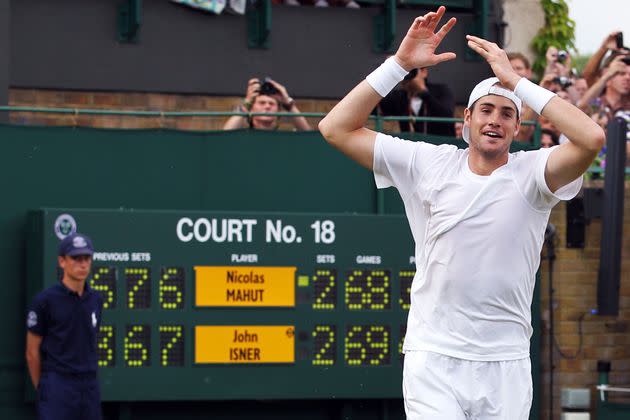Tennis Player Famous For Winning Sport's Longest Match Is Set To Retire
- Oops!Something went wrong.Please try again later.
- Oops!Something went wrong.Please try again later.
- Oops!Something went wrong.Please try again later.

John Isner celebrates winning on the third day of his first round match against Nicolas Mahut of France on Day Four of the Wimbledon Lawn Tennis Championships on June 24, 2010. The match is the longest in Grand Slam history.
John Isner will retire from professional tennis after playing at the U.S. Open, he announced Wednesday, bringing an end to a career that included one Grand Slam semifinal appearance and a victory in the longest match in the sport’s history.
“This transition won’t be easy but I’m looking forward to every second of it with my amazing family,” the big-serving, 6-foot-10 (2.08-meter) American wrote in a posting on social media that included a photo showing Isner, his wife and their four children.
“Time to lace ’em up one last time,” the 38-year-old Isner said, referring to the year’s last major tournament, which begins in New York on Monday.
Isner reached a career-best ranking of No. 8 in 2018, shortly after reaching the semifinals at Wimbledon, won 16 singles titles and has hit more than 14,000 aces, an ATP Tour record.
After 17+ years on the @atptour, it’s time to say goodbye to professional tennis. This transition won’t be easy but I’m looking forward to every second of it with my amazing family.
The @usopen will be my final event. Time to lace ‘em up one last time. ❤️ ♥️ 💜 pic.twitter.com/GyRTXGNK8G— John Isner (@JohnIsner) August 23, 2023
That includes 113 — the single-match mark — in his win against Nicolas Mahut that lasted 11 hours, 5 minutes across parts of three days in the first round at the All England Club in 2010 and ended at 70-68 in the fifth set.
There is now a plaque commemorating that contest on the wall outside Court 18, where it was played.
“Especially once the match got past, you know, 25-all, I wasn’t really thinking,” Isner said back in 2010. “Hitting a serve and trying to hit a forehand winner is the only thing I was doing.”
That match and Isner’s loss to Kevin Anderson by a 26-24 score in the fifth set in the semifinals at Wimbledon eight years later were a big part of the impetus for the sport’s eventual switch to standardizing tiebreakers in the decisive sets at all Grand Slam tournaments.
He was born in North Carolina and played tennis at the University of Georgia, helping the school win the 2007 NCAA team tennis championship, before turning pro that year.
